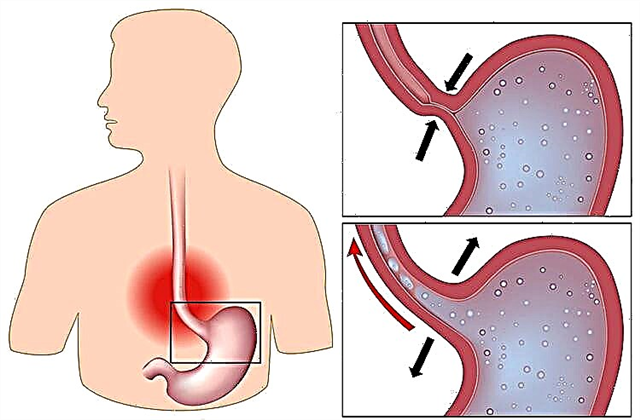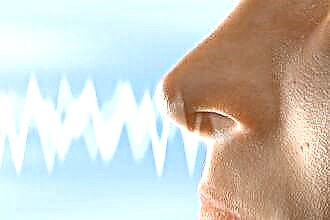With the onset of nasal congestion, many of us begin to use nasal drops with a vasoconstrictor effect. They, of course, help to restore nasal breathing, but long-term use of such drugs is fraught with addiction and dryness of the nasal mucosa. An old, proven treatment for rhinitis is rinsing the nose with saline.
The procedure can be carried out not only with salt, but herbal decoctions or antiseptic preparations. Nowadays, you can buy a ready-made solution with sea salt in a pharmacy (Marimer, Humer, Aqua Maris) or prepare a remedy yourself.
Saline solution can be used at any age for both therapeutic and prophylactic purposes.
What is the therapeutic effect?
 First, let's look at the mechanism of nasal congestion and rhinorrhea. The nasopharynx is the initial section of the respiratory tract, which provides purification, warming of the inhaled air, after which it enters the bronchi in a "useful" form.
First, let's look at the mechanism of nasal congestion and rhinorrhea. The nasopharynx is the initial section of the respiratory tract, which provides purification, warming of the inhaled air, after which it enters the bronchi in a "useful" form.
Around us there are many pathogenic microorganisms, dust particles, as well as allergens. The mucous membrane of the nasal passages is constantly moistened with a special secret, as a result of which pathogens, when a person inhales, "stick" to it and do not penetrate into the lower respiratory tract. To remove dust particles, the volume of secretion produced is increased, thereby clearing the surface of the mucous membrane.
Such precursors of a cold, such as sneezing and rhinorrhea, appear in response to irritation of the nasal mucosa. With a decrease in local immunity, pathogens enter the nose, begin to multiply and produce toxins. The defeat of the mucous membrane leads to the development of rhinitis, tissue edema and hypersecretion.
Rinsing the nose with a salt solution:
- ensures the restoration of the drainage function of the nasal mucosa;
- reduces the concentration of toxins in the secret;
- inhibits the production of secretions, thereby reducing rhinorrhea;
- reduces the viscosity of the discharge;
- eliminates pathogenic microbes from the mucous membrane, normalizes the composition of microflora;
- increases local immunity;
- reduces swelling of the mucous membrane, restores nasal breathing.
Indications
Freshly prepared saline solution for rinsing the nose is recommended for various forms of rhinitis:
- rinsing the nose with salt is recommended for the allergic form, when rhinorrhea develops due to the penetration of the allergen into the nose. Symptomatically, this is manifested by sneezing, profuse discharge, lacrimation, itching of the eyes, skin and swelling of the nasal mucosa;
- with a viral origin of the common cold, rinsing the nose with salt water prevents the addition of bacterial inflammation. Salt solution helps to strengthen local immunity, as well as prevent the spread of infection and inflammation;
- with an exacerbation of chronic bacterial rhinitis, rinsing the nose with salt water is necessary to reduce the number of microbes, the concentration of toxins and prevent the accumulation of purulent discharge in the paranasal sinuses;
- in the case of vasomotor rhinitis, nasal saline is indicated for the debridement of the mucosa, the improvement of the cilia and the restoration of the drainage function, which prevents the accumulation of mucus.
A saline solution is recommended for the prevention of exacerbations in chronic sinusitis or adenoids. If, when the first signs of an exacerbation appear, rinse the nose with saline five times a day, the symptoms of the disease will be less pronounced.
Preparation of the solution
As soon as rhinorrhea or sneezing appears, a nasal rinse is necessary. To rinse the nose, it is enough to have salt and boiled water in the house. Salt can be used sea or food, the effect will not change.
To prepare a saline solution, you must thoroughly dissolve 4 g of salt in 300 ml of water. Do not take cold water, it can irritate the mucous membranes and aggravate the course of the disease. The liquid temperature should be 40-45 degrees.
In case of increased nasal congestion, burning sensation or lacrimation, the procedure should be interrupted and a solution with a lower salt concentration should be prepared.
You can enhance the therapeutic effect of the drug by adding 2 drops of iodine to a saline solution.
Washing technique
 To properly rinse your nose with salt water, you must follow certain rules for the procedure. It is not recommended to force the solution into the nose; it is necessary to rinse it by gravity. Let's see how to properly rinse your nose with salt?
To properly rinse your nose with salt water, you must follow certain rules for the procedure. It is not recommended to force the solution into the nose; it is necessary to rinse it by gravity. Let's see how to properly rinse your nose with salt?
- first, you should take a special device for washing (it can be purchased at the pharmacy) or use any container that has a spout;
- the procedure is carried out in the bathroom, above the sink. In front of you, you need to place a container into which the rinsing water will drain;
- it is necessary to bend forward, as before washing your face, and turn your head to the right. Thus, one nasal passage will be located at the top and the other at the bottom;
- flushing is carried out holding the breath;
- you should open your mouth so that some of the water that enters the nasopharynx drains;
- position the edge of the container spout at the entrance to the right nasal passage;
- start pouring the solution into the nose;
- when the nasal cavity is completely filled with solution, it will begin to flow out of the lower passage;
- the duration of one wash is approximately 5 seconds;
- now we turn our head to the left and repeat the procedure;
- after washing each pass, you should blow your nose well. This will increase the healing effect for each subsequent wash.
Before starting the lavage, it is necessary to make sure the patency of the nasal passages. With severe swelling and the presence of a large amount of mucus, the procedure cannot be carried out. In this case, you must first "blow your nose" and then use salt to rinse your nose.
Can children rinse their nose? Sure. The procedure has no age restrictions, therefore it is recommended even for young children. Note that the procedure for washing the nose for babies has some nuances.
Features of the procedure
Cleansing the nasal mucosa must be carried out before each use of medicinal nasal drops (hormonal, antihistamines).
It is also not recommended to use salt often for a cold. For therapeutic purposes, the procedure is repeated three times a day, for prophylaxis - once a day. With an increase in the number of procedures, the risk of irritation of the nasal mucosa and increased secretion increases.
The nasal mucosa has a certain composition of microflora, which consists of beneficial and opportunistic microorganisms. Under normal conditions, the latter type of microbes does not cause the development of the disease. If the quantitative, qualitative composition of microflora changes, active reproduction of pathogens begins, which leads to the appearance of symptoms of the disease.
Treatment of a common cold with salt is an effective way to get rid of unpleasant signs of pathology. However, when the procedure is abused, the natural flora of the mucous membrane changes, the immune defense decreases and hypersecretion is observed.
When treating purulent rhinitis, care must be taken so that the purulent masses do not spread to the surrounding structures, for example, the auditory tube or palatine tonsils. This is observed when the rules of the procedure are violated. In the rinsing solution, you can add not only salt from the common cold, but antiseptic agents.
Salt nasal lavage is prescribed quite often by otolaryngologists for the treatment of diseases of the nasopharynx and paranasal sinuses. It should be remembered that it is not enough to use exclusively saline solutions in therapy, and with frequent use it is even dangerous. Considering this, it is necessary to comprehensively influence the disease, and also not to forget about strengthening the immune system.



